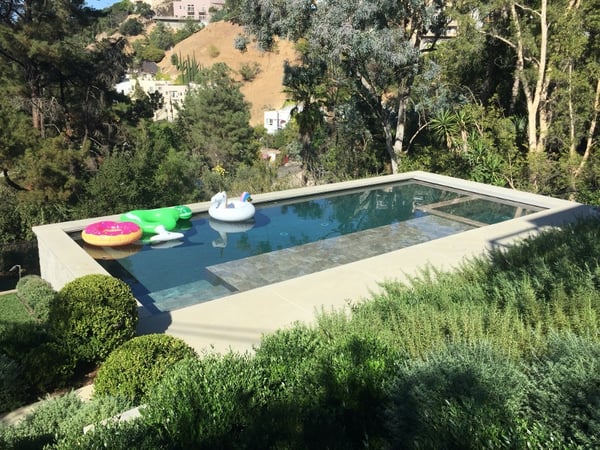Do You Need a Soils Report Before Pool Construction in LA?
The Hidden Soil Risks That Can Destroy Your Pool and Budget Why a Proper Soils Exploration Is Critical Before Building a Pool: A homeowner’s guide to...
5 min read
Daniela Escudero
:
Dec 12, 2022

It seems as though California was made for pools. But what about the price?
When it comes to luxury and quality, inground concrete pools have remained a popular choice for homeowners in California for quite some time. But how much does an inground concrete pool cost?
Deciding to build an inground concrete pool for your home is an exciting venture. An investment that you and your family can enjoy for generations. However, cost, like with anything else, is always one of the main factors. One that can’t be taken lightly.
J Designs Pool and Spa has been building inground concrete pools for 14 years, of all shapes and sizes. When it comes to pricing, we always strive to be upfront and honest with our clients so they know exactly what it costs to build the pool of their dreams.
By the end of this article, you will know the base price of an inground concrete pool as well as the additional factors that can feed into that estimate, the add-on features that can increase that cost, and maintenance costs.
That way, you have the knowledge that you need to make an informed decision about what is best for you and your home.
Let’s get started!
When it comes to building an inground concrete pool, the base price for that will be a range of $58,000 - $75,000.
That range is in place because no pool is alike. Also, this pricing quote does not include the spa, materials, add-on features, and amenities, which we will discuss later.
When you hear the base price, it is just that, the basic components for a pool, like excavation, steel, plumbing, shotcrete, and white plaster; some builders will include the basic equipment on their price, like a pump, filter, and lights; some others don't.
Several factors go into the pricing of a pool, such as the size of the pool, what materials were used, and what kind of plaster finish it has.
When it comes to selecting your pool size, the base pricing will start at a minimum pool size and increase if you decide to build larger. This will require more materials that are being used, as well as a larger labor force.
Decreasing the size of your pool below the base sizing will not decrease the base pricing.
No matter what, you will still need the same amount of initial labor to help complete the project. Even though you might not use as many materials, their hours of work and transportation still must be accounted for.
For example: if you build a pool that will require less shotcrete, you will still require the same truck to transport the material to you, and the same amount of laborers to apply the shotcrete.

Just as important to the pricing of a concrete inground pool are the raw materials that it’s made of.
Concrete pools consist of a mixture of cement and sand applied to the metal frame (or rebar) of the pool through a wet shotcrete or dry shotcrete (gunite) process. Wet shotcrete is pre-mixed off-site and transported to the property by cement trucks, while dry shotcrete is mixed at the pool site.
If there is a shortage of the materials needed to build your pool, that could result in you paying a higher-than-normal price due to scarcity and higher demand.
As gas prices increase, the cost of transportation of those materials will increase, whether by trucks, trains, or silos.
Do you want your pool to look like a sandy blue beach? Or would you prefer a dreamy lagoon? It all comes down to the type of plaster that you use for its finish.
One of the biggest draws of concrete pools is that through the type of plaster finish you use, you can customize them to resemble any body of water found in nature: lakes, oceans, and seas.
Concrete pools can have many types of plaster finishes, from the traditional white plaster to the more textured aggregates (pebble, glass, seashell). If you want to know more about the different types of plaster finishes, please check out What Type of Plaster Is Right For Your Pool: Pros, Cons, and Comparisons.
Along with plaster, other materials such as specific types of tile will also add to the overall finished look of your inground pool. This tile can come in many colors, types, and shapes. If you want to know which tile is best for you, please check out Glass Tile vs. Ceramic Tile: Which is Best For Your Pool.
Each finish has its own price point, which can increase the base price, with white plaster being the least expensive and sometimes included in the base price and glass tile being the most expensive.
Adding special features to your inground pool will increase its value and deepen that personal touch that makes your concrete pool unique and uniquely yours.
The added price of these features will be tacked onto your base price for your concrete pool since it is essentially built from the ground up.

Certain add-on features that will increase the price of your concrete pool:
Not sure if you want to include any upgrades when you first start building? No worries. Remember, these are features that can be included in the initial contract or added at a later date.
One area not to cut corners is the overall maintenance of your pool. In terms of maintenance costs, a pool service professional will typically charge you $200-$500 per month for regular cleaning. This depends on the size of your pool and location.
The service cost for maintaining a pool also depends on the sanitation equipment that your pool has.
Even though concrete pools are the most durable type of inground pool, that doesn’t mean they require any less regular care to make sure they’re looking and performing at their best.
Since the foundation for concrete pools is concrete and steel, all of the maintenance involves the surface area (tile, plaster, coping, etc.). The finish and coping of your concrete pool are the most affected by your pool’s water chemicals because it has the most contact with them.
This all factors into how much maintenance will be required and the pricing for that maintenance as well.
A well-maintained pool can last a lifetime. Surface materials can last 8-20 years depending on how much the pool is used.
Wrapping up, you now know the base rate for an inground concrete pool built from the ground up, as well as the different factors that go into that pricing. You also know the finishes and add-on features that can increase that cost, and maintenance costs.
So with this knowledge, you’re probably asking yourself: is a concrete pool worth it?
In terms of cost, concrete pools are definitely at the top of the pyramid of pool types. In terms of durability and aesthetics, concrete inground pools have been popular with California homeowners for a reason.
At J Designs Pool and Spa, we pride ourselves on having helped nearly 200 families construct their inground concrete pools. Being designers and builders, we make it our mission to customize your dream pool and make it a reality, no matter the size or shape.
We make sure to be transparent and set realistic expectations for our customers in terms of pricing and the factors that go into that pricing.
If you want to talk to a professional about an inground concrete pool, schedule a consultation with one of our experts.
Not ready to speak with us yet, but would still like to know more? Check out these related articles for further information!
Inground Concrete Pool Construction Process: 8 Steps and What You Need To Know
What's an Ozone Generator and Why it's Great for Your Pool

The Hidden Soil Risks That Can Destroy Your Pool and Budget Why a Proper Soils Exploration Is Critical Before Building a Pool: A homeowner’s guide to...

Why Pool Coping Fails - How to Avoid Expensive Repairs If you’re planning a new pool or renovating an older one, it’s completely normal to feel...

Have you ever wondered why your pool company talks about “certified technicians”? Or why does Los Angeles County require strict training and testing...